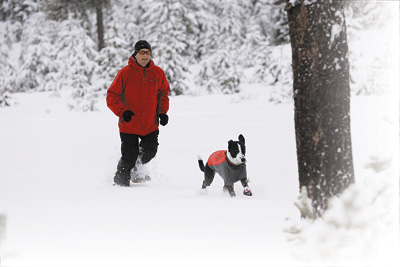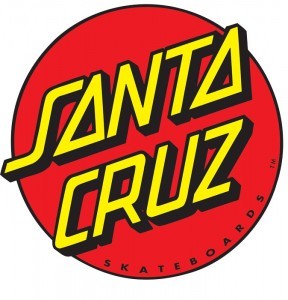- Tahoe’s Nevada Beach Tops the List of Hard-to-Book Campgrounds - 07/17/2024
- Cannabis Watershed Protection Program Cleans Up Illegal Grow Sites - 07/10/2024
- French Fire - 07/05/2024
Comfort and safety considerations for four-legged winter companions
By Christa Fraser and Pete Gauvin • Photos courtesy of Ruff Wear
 If your dog looks like an Alaskan malamute or a Swiss mountain dog, chances are your pooch takes to snow like a five-year-old Norwegian kid. Certain dog breeds, such as Huskies and St. Bernard’s, have been bred for cold weather pursuits for centuries.
If your dog looks like an Alaskan malamute or a Swiss mountain dog, chances are your pooch takes to snow like a five-year-old Norwegian kid. Certain dog breeds, such as Huskies and St. Bernard’s, have been bred for cold weather pursuits for centuries.
However, if your dog is not one of those thick-coat snow-adapted canines and spends most of his days running around in milder climates and suburban backyards, you may need to prep your pooch before heading for the high country, perhaps even buy him a new outfit or at least some winter accessories.
Winterize Your Pooch
Dogs are a lot like taking a car to the mountains. Properly trained and conditioned, even the canine-equivalent of a low-slung sedan can participate in a variety of cold-weather outdoor pursuits, including snowshoeing, cross country and backcountry skiing – snow and weather conditions permitting.
Yet even if you consider your dog an SUV-type breed, like the ever popular Labrador Retriever, don’t be over-confident in their snow-covered driving abilities. You may find your find your four-legged friend stuck in a snow bank like a teenager behind the wheel of the family Ford Explorer.
“The first time I brought Milo, my 8-year-old newly adopted black lab, up from San Francisco to the Sierra, I noticed the snow turning red where he had stepped and realized that his paws were bleeding from snow abrasions,” says Anna Siebelink, a Truckee resident and owner of three dogs. “I was so used to having my other two dogs out in the snow, backcountry skiing and hiking, that I neglected to properly condition Milo for even a short hike in the snow.”
Whether for a day trip or a pack-in/pack-out overnighter, dog conditioning and weather conditions are as important as good tires, an effective defroster, a full tank of gas, and conservative driving habits.
“What is the temperature? How long will you be out? Is it sunny and bright? Is it icy, or deep powder? Is your dog used to being in the cold air? These are some things to consider before taking your dog out in the snow to exercise,” says Truckee veterinarian Dr. Heather Simon.
“Dogs can split their pads from running on sharp ice. They can get ice wedged between their toes that can result in frostbite, pain and lameness. They can post hole in the powder potentially leading to serious tendon or ligament injury. They can get sunburn on their noses or eyes, pneumonia from panting in the frigid air, and they can get sore and dehydrated.”
Remember, Dr. Simon points out, a dog dashing about can easily cover twice the distance you do in the same amount of time.
Friends and Partners
Snowshoeing is an easy way to cover terrain at a comfortable pace for you and your dog. It’s also great training to prepare for cross country or backcountry ski trips together. Teach your dog to follow your tracks if he doesn’t relish breaking fresh tracks himself.
If you’re at all uncertain of the toughness of your dog’s paws on snow and ice, use or bring dog booties or gauze bandages and tape. The gauze can also come in handy if your dog sustains a laceration from a ski edge – a relatively frequent injury, often inadvertently owner inflicted, among dogs galivanting around people on skis.
If you’re going to be out more than an hour or two, endurance might be a concern too – particularly in deep snow. Bring extra treats in case your dog begins to bonk, as well as water. Be sure to offer water periodically. Don’t assume your dog will stay hydrated eating snow.
When you’re confident that your dog can handle the snow comfortably, try cross-country skiing. With a little training (and a good helmet), the two of you can advance to skijoring.
Norwegian for “dog-driving,” skijoring is a bit like mushing without the sled. Using a towline and harness, your dog pulls you while you follow on skis. Just make sure you’re a competent skier because, as we mentioned, your ski edges can seriously injure your pooch in a collision. For details on skijoring and regional trail suggestions for the Tahoe area, visit champion skijorer Mike Callahan’s site, www.skijor.com.
You can also take your dog into the backcountry and into the steeps if your dog has the stamina. Remember a skier can cover far more ground with greater ease than your four-legged friend, so you may need to periodically stop and rest. To keep owner and dog safe, you should have avalanche training so you can recognize potential hazard areas before they slide. Dogs can trigger avalanches by running up, down, and across slopes. And they can become an avy victim by slides set-off by their skiing owners.
There is some controversy about the best avalanche safety measures for dogs. Some people advocate fitting your dog’s collar with an avalanche beacon or a BIP transmitter. Critics say this decreases the chances that people would be rescued first in the event of avalanche burial because transceivers can’t tell the difference between a dog’s or a person’s beacon.
Other backcountry dog lovers say that using a long line connecting you to your dog when traversing an uncertain slope is the best idea. Either way, in the case of an avalanche you may be your dog’s only way out.
Gear Hounds
No matter which cold weather activity you partake in, your dog must be comfortable in the elements. Just like you, he may benefit from some well-made, technical equipment:
- Jacket — Lean, short-haired dogs may require a snow jacket. Look for one that offers wind-resistance and protects the majority of the dog’s underbelly. The fit should be snug without chafing under constant motion. For a windproof softshell, try the CloudChaser by Ruff Wear ($75, www.ruffwear.com).
- Booties — Many dogs, even some sled dogs, need to use booties. Snow can ball up and turn into ice between a dog’s pads, causing debilitating pain. Look for booties that offer a no-slip tread. Your dog should be able to spread his paws out and still have good mobility but the booties should not be big enough to cause a clumsy or exaggerated gait. Try Ruffwear’s Bark ‘n Boots Grip Trex ($59.95 for a set of four) and liners ($9.95/pair), or GraniteGear Musher Boots made with the same climbing-skin fabric used for skis ($18.00/pair, www.granitegear.com). If you don’t use booties, regularly check your dog’s pads for injuries and frostbite.
- Goggles — No joke. Cartoonish as they look, dog goggles can protect your dog’s eyes against cataracts from bright high-altitude snow-reflected sun and from flying snow in nasty conditions. For shatterproof, anti-fog UV protection, try Doggles ILS ($21.99/pair, www.doggles.com)
- Leash — Leashes are mandatory in many backcountry areas. Regardless, you may want to keep your dog on leash anyway since dogs can easily lose your scent in the snow and get lost. Buy a shock-proof leash like the Granite Gear Absorber Leash ($13) so you won’t be jolted if Nanook bolts after a snow bunny.
- Pet First-Aid Kit — Bring a first-aid kit for your pooch or pack extra pooch-specific supplies into your kit. Ruff Wear offers a 13 oz. K-9 first-aid kit that includes a pet first-aid manual ($45.95)
Extended Trips and Overnighters
If you’ll just be out for just a few hours, carry all the supplies for you and your dog in your backpack. If you plan on snowcamping, your dog can shoulder some of his own load. However, try to keep the load weight under 10% of your dog’s weight if he isn’t in good shape. Fit dogs can carry as much as 25% of their own weight, if necessary.
- Packs — When selecting a K-9 backpack, look for one that fits snugly without chafing or sliding around. Choose a size appropriate for the amount of supplies your dog will be carrying. There are several high quality products available, including the Palisades Pack II from Ruff Wear ($74.95 – $94.95), the Kelty Chuckwagon ($45 – $60, www.kelty.com) and the Mountainsmith Dog Trippin’ Kit ($69.95 – $89.95, www.mountainsmith.com), which includes food and water bowls, a shock-absorbing leash and a sleeping blanket.
- Pup Tents — If you need a little privacy and your dog smells like, well, a wet dog, then a pup tent may be in order. Keep in mind, though, that your dog may refuse to sleep solo. Try the REI Adventure Dog Tent ($40, www.rei.com) or Uhlr Gear’s Pup Tent ($29.99 to $39.99, www.uhlrgear.com).
- Sleeping Pad — To stay insulated at night, a sleeping pad for your pooch is a necessity. The Mt. Bachelor Pad from Ruffwear packs up tight ($49.95).
- Sleeping Bag or Blanket — Bring a sleeping bag for your dog if he tends to run cold. Uhlr Gear offers the integrated Sleeping System for cold-sensitive hounds ($35.99 to $47.99).
- And don’t forget the cardinal backcountry rule — pack it out! Bring a roll of biodegradable waste bags.
Nutrition and Hydration
It’s up to you to keep your dog hydrated and well-fed when trekking through winter conditions. Carry your dog’s water or melt snow for them. Again, don’t presume that they’ll stay hydrated by eating snow.
Dogs can usually carry their own food, however. Bring high-calorie, high-fat food to compensate for the extra calories used to stay warm. Zukes sells PowerBones, endurance treats designed to keep active dogs from bonking ($5.59/bag, www.zukes.com).
Deciding to bring your four-legged bud into the winter backcountry is a serious consideration. While it creates special safety concerns, the rewards are well worth it. Plan ahead and you might become best buds in the backcountry, too.













